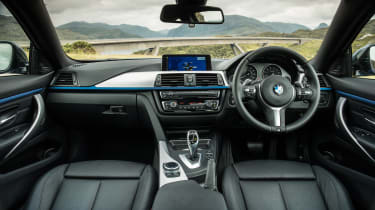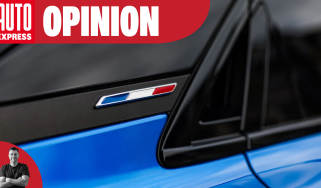Used BMW 4 Series (Mk1, 2014-2020) review - How practical is it?
Space in the cabin is pretty good for a coupe, but the boot is a touch shallow
This is a coupe and there are practicality penalties that come with the slippery shape. The 3 Series saloon is a more practical car than the 4 Series coupe but next to its sports car peers, the 4 Series stacks up relatively well. The rear seats are roomier than you might think and there’s no issue with space for front-seat occupants.
Dimensions and cabin design
The 4 Series more or less mimics the 3 Series saloon with its 4,638mm length and 1,825mm width. That makes it a manageable size for being wieldy and manoeuvrable in tight spaces, but gives the car enough of a footprint that it won’t feel cramped inside, although of course the lower roofline does rob some headroom, especially in the back.
When it comes to cabin space, the 4 Series is not bad. Yes, the back seats are best kept for shorter journeys, but you’d be surprised just how tall someone needs to be before they feel uncomfortable back there. The front seats are excellent though – the standard ones don’t look all that exciting when you see them, but they’re wonderfully comfy and supportive and there are lots of sportier options for extra bolstering and side support. Plus, unlike a lot of modern sporty cars, you can get the seat low to the ground for a proper sports car driving position.
It’s worth remembering that not all 4 Series models have three rear seatbelts, which can limit the car’s practicality somewhat. Okay, so you’re probably not going to expect to squeeze three people into the back often, but you never know when an extra belt set will come in handy.
Used - available now

2023 BMW
4 Series
20,345 milesAutomaticDiesel2.0L
Cash £28,178
2020 BMW
4 Series
27,565 milesAutomaticPetrol2.0L
Cash £17,760
2020 BMW
4 Series
42,760 milesAutomaticPetrol2.0L
Cash £16,387
2023 BMW
4 Series
62,300 milesAutomaticDiesel2.0L
Cash £23,697There is more room in the back than in the current Audi A5 and Mercedes C-Class Coupe and a little less than you get in larger models like a Mercedes E-Class Coupe, but it’s adequate on the whole. Less good is the Convertible, which forces the rear seats into a more upright position to make room for the roof stowage. This sounds like a small thing but it makes a huge difference to comfort on a longer journey for anyone relegated to the back.
Again, of course, if you want your 4 Series to be a bit more practical you can upgrade to the five-door 4 Series Gran Coupe, which has a bigger boot, if not actually any more usable space in the back seats.
Boot space
A 445-litre boot is pretty decent, but you do need to remember that it’s a little shallower than that of the 3 Series saloon and that the aperture isn’t very wide on the coupe. Folding rear seats are also not standard, so remember to tick that box if you want your 4 Series to be as practical as possible.
Equipment and technology
Although everything’s a little lower-slung, the 4 Series is basically the same as the last 3 Series inside, and there isn't anything wrong with that. You get all the bits you expect from a BMW – clear, handsome instruments, great seats and a steering wheel that feels just right in the palms of your hands. Quality is generally excellent, although the less well-appointed versions can look and feel quite plain. There are also some cheap plastics to be found if you go looking.
It’s best to avoid the default black leather trim. Practical it may be but it just sucks all the light from what is already a very dark cabin. Beige or biscuit-coloured leather might be a bit harder to look after, but it really lifts the ambience inside.
You can, of course, go mad on the spec of the interior by adding sportier seats, carbon or wood trim and lots more. It’s best to keep a sensible head when perusing the options list though. The standard seats are just fine and too much wood makes everything look a bit Eighties – keep things simple, choose some bright colours and lots of add-ons for the infotainment and you won’t go far wrong.
The basic infotainment comes with a 6.5-inch screen and the iDrive system with its rotary controller and ‘hot-key’ buttons. It’s just fine in this form, and it comes with DAB radio as standard.
The iDrive system has also improved out of all recognition since it was introduced in 2001 – it’s now one of the slickest and simplest of such systems to use. Upgrades include a bigger screen (the presence of which really lifts the cabin ambience), live traffic updates in the sat-nav, a Harman-Kardon sound system, head-up display, parking cameras and more.
Added to which, BMW’s Connected set-up now offers buyers a lot of extra options, although many can only really be exploited when the car is sitting still. Weather and news headlines can be accessed once you’ve selected upgrades, plus you can specify a very useful Wi-Fi hotspot, which can also use the car’s aerial to boost your mobile phone’s reception.
Safety
The 4 Series wasn’t crash tested as a coupe by Euro NCAP, but the 3 Series it's based on was tested in 2012, and it scored a maximum five stars. As the two cars are all but identical under the skin, you can expect pretty good safety standards from the 4 Series. There are also lots of extra safety options you can choose from, such as adaptive cruise control, adaptive LED lights, lane-departure warning and forward-collision alert with city collision auto-braking.






